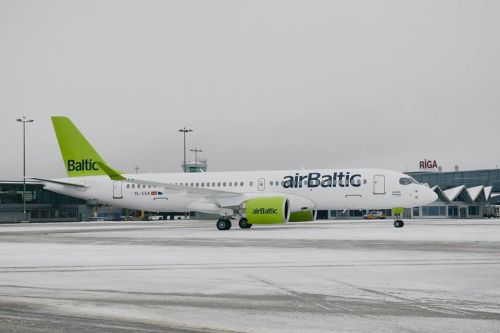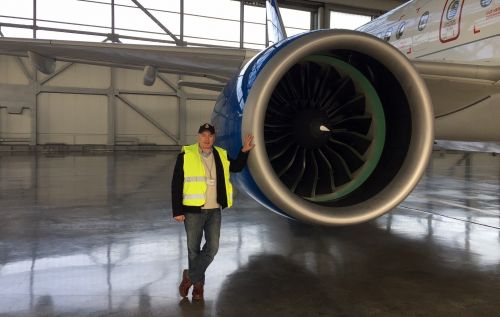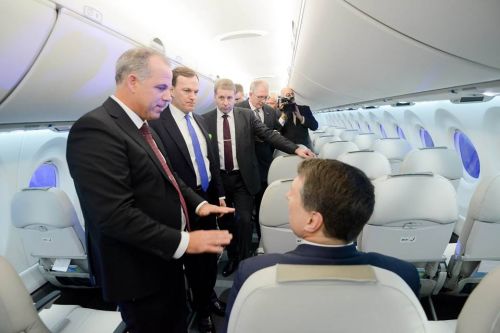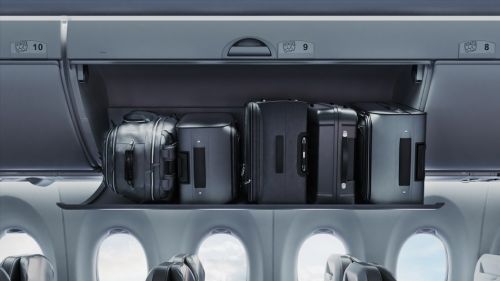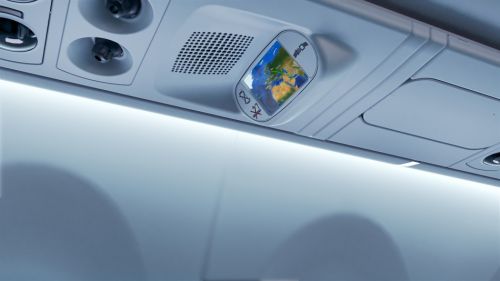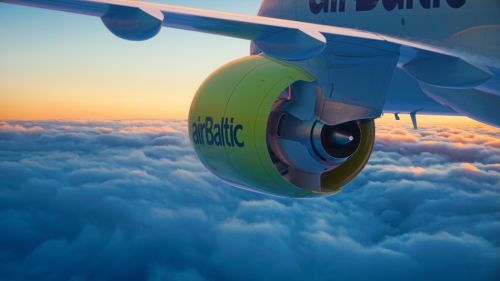The airBaltic airline (Latvia) is the first airline to take delivery of the Bombardier CS300 airliner for commercial operation. The airline officially presented the new airliner on 1 December. CFTS correspondents attended the presentation and shared their impressions.
Unlike its competitors, the CS300 airliner is not an upgrade of a previously successful model but a completely new aircraft. It has already been nicknamed the "plastic plane" because of the significant number of composite materials used in its construction. There is widespread use of composite materials on the aircraft – from its cabin and lavatories to its structural elements. The undercarriage door, the wings, and the non-structural panels of the fuselage are made of composite materials. Rivets are visible only in the area of the center wing.
The Canadian aircraft should provide a breakthrough in airline cost reduction. Bombardier claims that the aircraft’s new PurePower PW1500G engine, which is manufactured by the Pratt & Whitney company, and the special shape of the aircraft’s wings will provide fuel savings of up to 20% compared with its competitors' current models (the Airbus 320neo and the Boeing 737NG airliners). The huge diameter of the revolutionary new engines is noticeable because of the increased size of its fan. The engine design facilitates significant fuel savings. The design of the engine is truly revolutionary. It is a hybrid between a turboprop and a jet engine.
In addition, the CS300 airliner is nearly 8 tons lighter than the Boeing 737-7MAX and 6 tons lighter than the Airbus 319neo. This, together with other innovations, helps the Canadian airliner to achieve up to 12% savings in operating costs compared with the latest-generation competitors and 15% compared with the current market-leading models.
In addition, the Canadians are essentially revolutionizing the market of aircraft technical maintenance. For the CS300 airliner, the initial time between overhaul (TBO) is 8,500 hours and the interval between “A checks” is 850 hours, which are significantly longer than the intervals for the airliners that are currently flying.
There are six monitors in the cockpit instead of the traditional eight. It is controlled manually (with a joystick) and not with a control wheel. There are few switches and mechanical moving parts here because the systems are controlled from monitor screens.
The absence of protruding parts - landing lights - on the fuselage is noticeable and the number of antennas, various fairings, and others is reduced to a minimum, which reduces drag and saves fuel.
The cabin of the Canadian airliner is very friendly to passengers and onboard personnel. The airliner that was delivered to airBaltic has a dual-class layout with 145 seats. In accordance with the established continental European tradition, the business and economy classes are equipped with the same seats, which differ only in terms of seat pitch - 32 and 30 inches, respectively.
The CS300 airliner has a spacious cabin and the aisle between seats is wider than the aisles in competing aircraft, which allows flight attendants with trolleys to pass passengers. There are large illuminators in the cabin. The carry-on luggage bins are made in accordance with the modern market requirements – each passenger has space for above-standard carry-on luggage (a 10-kilogram suitcase with dimensions of 24x17x11 inches), which can be placed on their sides. The luggage bins open lower than those in competing aircraft: firstly, it is easier to place and retrieve luggage; secondly, even a person of below-average height (175 cm) can see whether he has forgotten something in the bins.
The new seats deserve a special mention. They are 19 inches wide. That is 2.5 centimeters wider than Airbus seats and almost 5 centimeters wider then Boeing seats. Furthermore, when a passenger reclines his seat, the lower part of the seat pushes forward by 0.5-1 centimeter, increasing the seat’s angle of inclination.
The CS300 airliner has a convenient and compact kitchen that allows simultaneous heating of food for practically all passengers. At the same time, the Canadian manufacturer did its best to ensure the safety of passengers and flight attendants. For example, trolleys are placed in the kitchen in a way that ensures that they cannot roll out of the kitchen unattended. Boilers and stoves will not turn on unless they are filled and closed properly. The lavatory in the new aircraft is also considerably more spacious.
In total, the airBaltic airline has ordered 20 CS300 airliners. The second aircraft will arrive by Christmas and two more will arrive at the beginning of next year. The Latvian airline hopes to receive all the ordered airliners by the end of 2018. The CS300 airliner will gradually replace the airline’s current fleet of narrow-body aircraft: Boeing 737 300 and Boeing 500 aircraft. Initially, the Latvian airline planned to stop operating the Boeing 737 aircraft by 2018, but it decided not to rush the return of the Boeing aircraft until at least 2020 because of delays in delivering the Canadian aircraft and a slight revision of the airline’s flight development strategy.
In contrast to the classic Boeing 737 airliner that airBaltic currently operates, the CS300 airliner can be flown on a distance of 6,000 kilometers, which will allow the airline to fly from Riga to anywhere in Europe, the Canary Islands, and Abu Dhabi.
(Photographs by O.Lanetskij and airBaltic).

